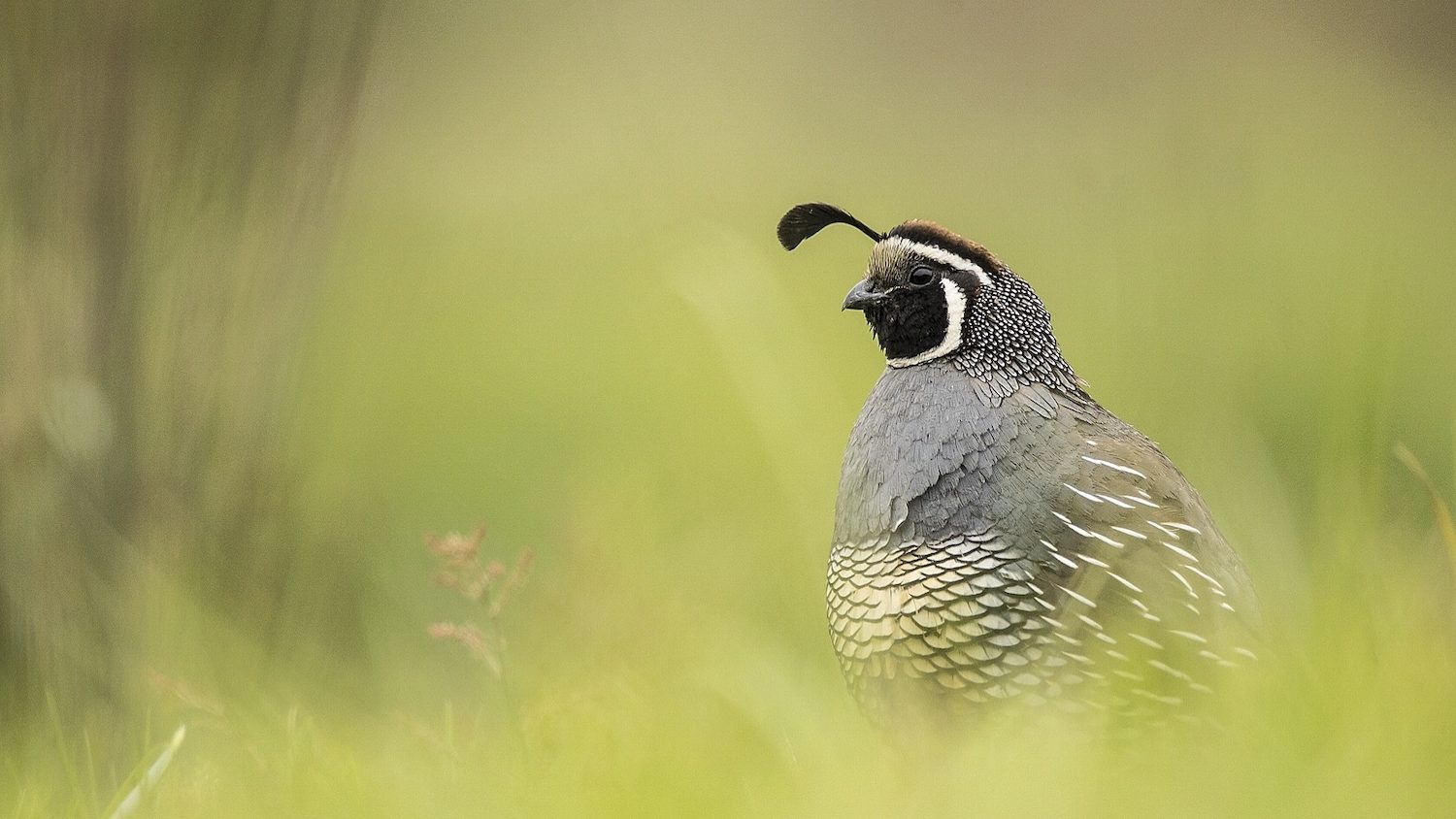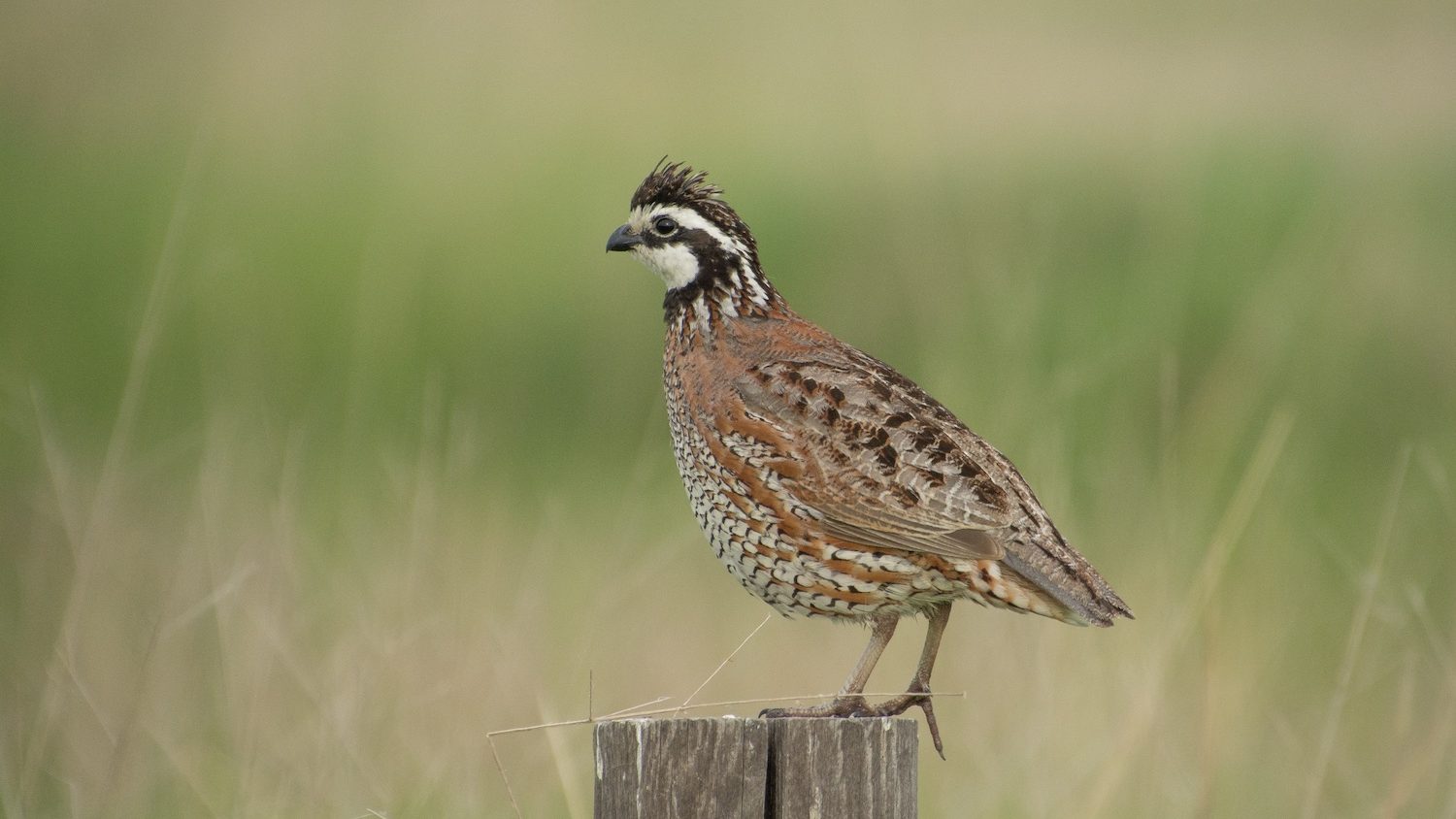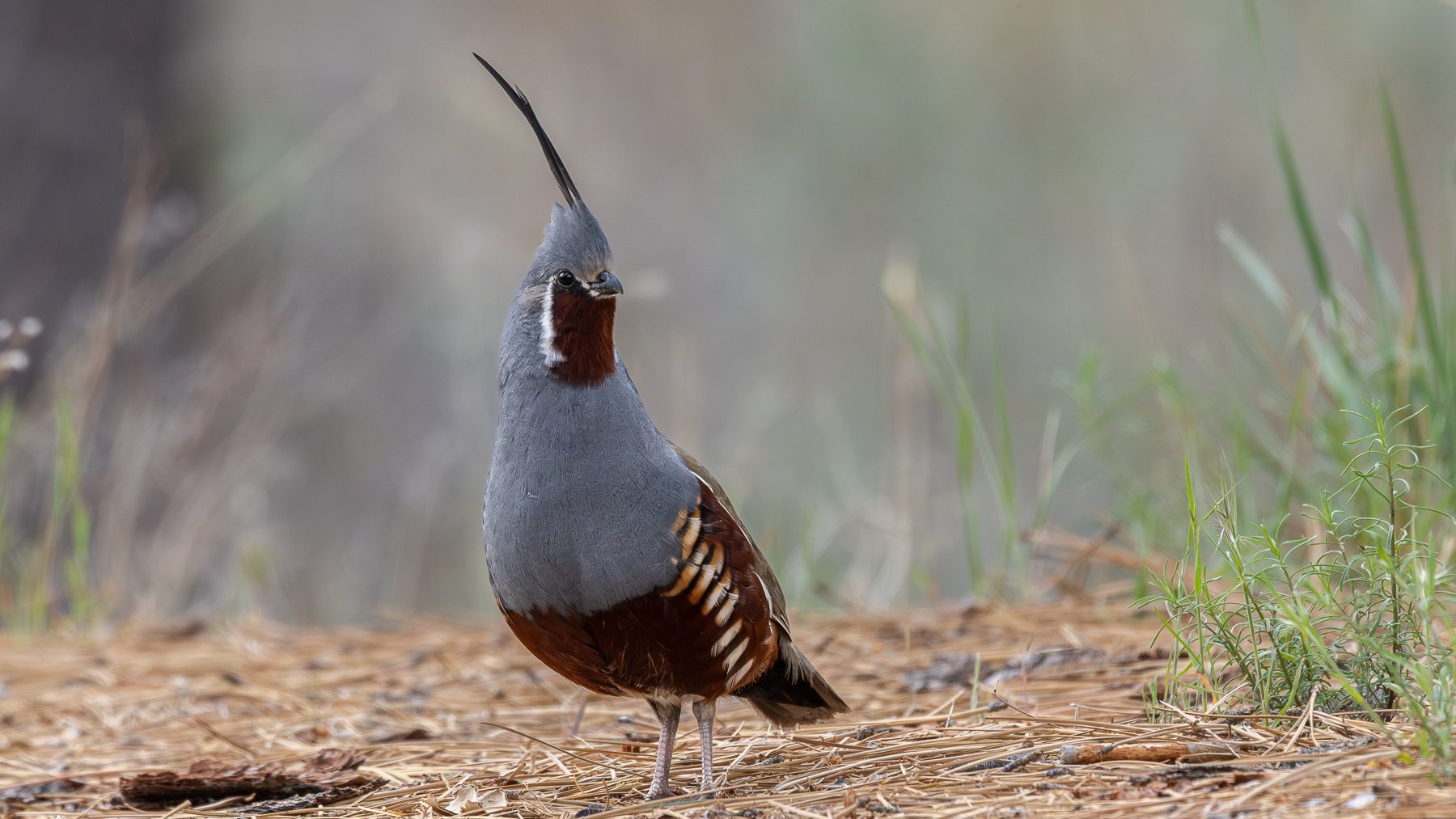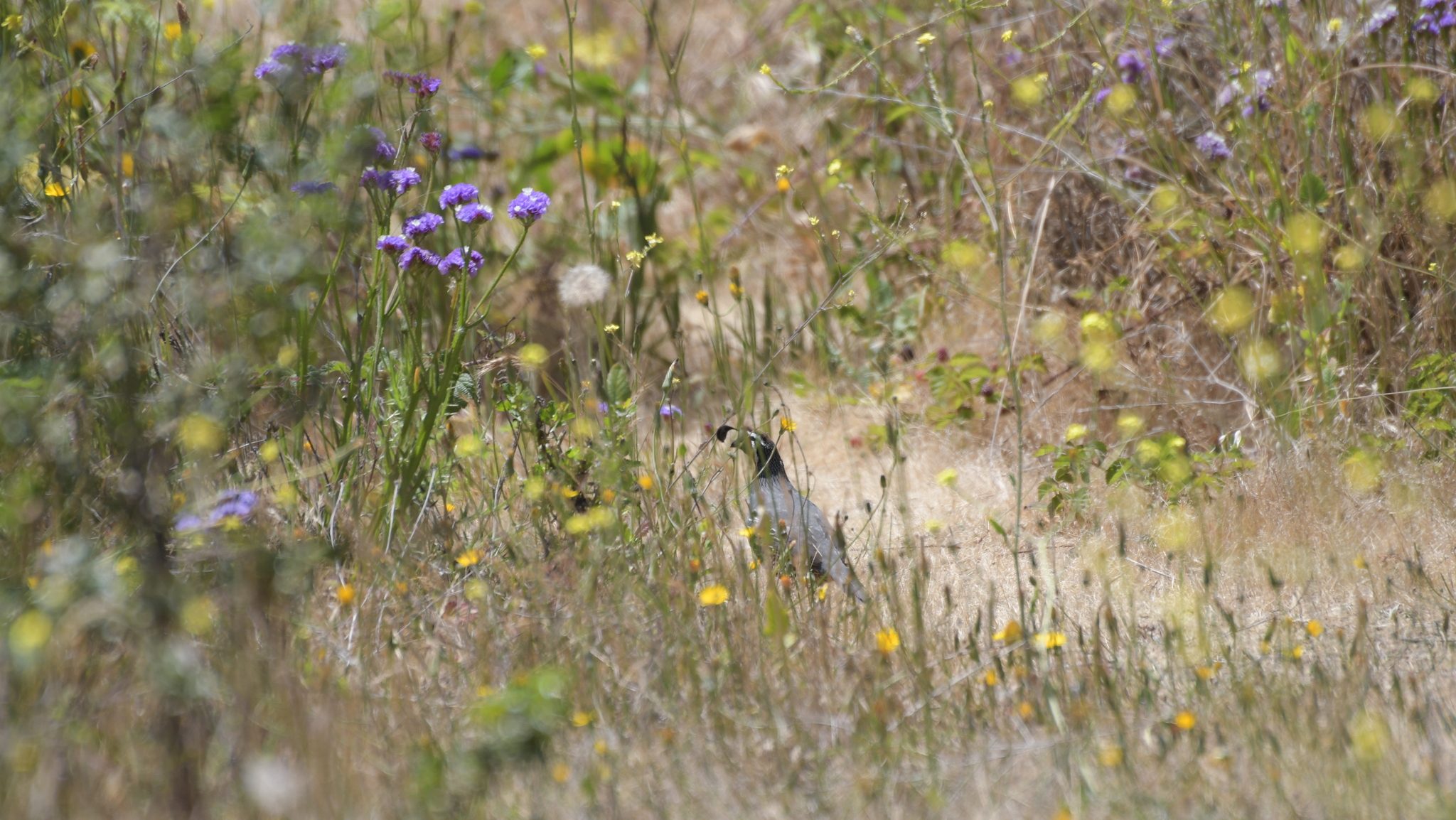I started my work day this morning with a view of a male California quail, standing on a backyard stump. Its head tilted back, its characteristic topknot wiggling, it let out a call that David Allen Sibley describes as “putt way doo.”
When I first moved to Boise, Idaho, the sight of quail coveys moving through backyards and city parks seemed unusual. This was not the expected suburban bird. Twenty-four years later, “putt-way-doo” is the sound of home. I observe quail daily as they go about feeding, dust bathing and evading predators.
Unlike many bird species, the California quail is actually increasing in population. It thrives in native habitat as well as in irrigated agricultural areas and suburbs. Let’s take a closer look at one of my favorite western U.S. birds.
Meet the California Quail
The California quail (also commonly known as the valley quail) is native to the West Coast of the United States. As its name implies, the heart of its range lies in California, but its native range runs from Baja to Oregon.
It is an attractive bird, with a variety of brown and gray hues, including a scaled appearance on the chest. Both sexes have the quail’s most notable feature, a topknot of feathers on the head, but this is much more noticeable in males. According to the Cornell Lab of Ornithology, this topknot is not a single feather, but is “actually a cluster of six overlapping feathers.”

It is such a charismatic bird that it’s a frequent subject in folk art, illustrations and cartoons. Holiday art that depicts a “partridge” is often in reality a California quail.
As I write this in early summer, California quail are paired up. They will soon nest and hatch a brood of chicks. They’ll then rejoin other quail to form a flock, often called a covey. The common “putt way doo” call you hear throughout quail range is actually a locator call. When the covey scatters, they call to each other to reassemble.
According to Cornell, the California quail has protozoans in its intestines to help it digest vegetation; “chicks acquire the protozoans by pecking at the feces of adults.”
In its native range, California quail are found in brushy chapparal vegetation. They survive in arid habitats, but often are not far from a creek or other riparian vegetation. This mix of habitats, it turns out, is replicated in human-altered areas of the arid West.

The Spread of the California Quail
The bird Order Galliformes includes pheasants, quail, grouse and turkeys, often referred to in the U.S. and elsewhere as “upland game birds.” These birds are particularly popular with hunters, which in turn makes them the focus of many conservation projects.
Hunters often cite their positive impact on conservation through the purchase of license fees and the support of habitat conservation organizations. And it’s true that many game species have benefited from this. It’s also true that, despite the attention, many upland game bird populations have undergone notable declines over recent decades, including greater sage-grouse, prairie chickens, ruffed grouse and sharp-tailed grouse.
The northern bobwhite, an eastern quail species, has seen its population reduced by as much as 80 percent over the past 50 years. The reasons include habitat loss, changes in agricultural production, pesticides and invasive fire ants.

Idaho’s native quail, the mountain quail, has disappeared from most places in the state. It is found in hilly, arid regions. It once could be found in the Boise foothills just above my home. No more. Reintroduction programs have experienced only modest success, at best. I have never seen one.
Amidst all this gloomy news, the California quail offers a different story. Its populations appear to be increasing. That’s in no small part due to human assistance. Because of the popularity of bird hunting, state game departments spread the California quail to suitable habitat around the West. While it is possible and even likely that the quail would have spread on its own, the transplants instantly increased the quail’s range to inland Oregon, eastern Washington and Idaho. Initial introductions began as early as 1872 in Idaho. (The species has also been introduced much farther afield including to Hawai’i, New Zealand and Argentina).
The mix of arid and riparian habitat of its native habitat was replicated in natural and human-altered ecosystems in its new western home. They are common in the “sagebrush sea” that spreads across Idaho and eastern Oregon. But unlike some species that need intact sagebrush – like the sage grouse and pygmy rabbit – the California quail can thrive in any brushy habitat.

In fact, it seems to do best where there is a mosaic of open area for foraging, nearby brush for cover and nesting and a source of water. This just so happens to define a lot of Idaho agricultural areas and even suburbs.
The place I’ve seen the largest numbers of California quail – often hundreds in a day – is an organic farm that sets aside large chunks of habitat for wildlife. There is a canal that runs through the property, lined with thick vegetation. The quail will forage in the fields and along the edges. The farm is bordered by sagebrush and includes trees that were planted long ago to shelter buildings from winds. It’s a mix of natural and agricultural and the quail thrive.
The same is true of my neighborhood, bordered by a wildlife management area and a short walk (or quail flight) from a river. We’ve planted parts of our yard in native and drought-tolerant vegetation for pollinators. There’s also the usual mix of suburban trees and shrubs, with the added bonus of bird feeders. Quail can often be seen feeding at the seed spilled by songbirds and squirrels.
While many species have declined due to these altered habitats, the altered habitats fit the quail’s needs nicely.

Of Hawks and Quail
There are, of course, other species that adapt to suburbia, including raptor species like Cooper’s and sharp-shinned hawks. Research has found these hawk species have moved back into suburban and urban areas to take advantage of the easy hunting found at birdfeeders.
This is true across the United States, where hawks target starlings, house sparrows and native songbirds. But I’ve found locally that quail are the preferred target, offering a much plumper, meatier meal.
During winter, it creates a dramatic spectacle of suburban predator-prey interactions. The Cooper’s hawk will dive bomb into a quail flock, often snagging a bird before it takes flight. I have seen a hawk capture a quail in my yard, then methodically pluck the feathers off its breast before digging in for its meal.
While walking the aforementioned organic farm, I have even had Cooper’s hawks follow along. When quail flush in front of me in a noisy blur of wings, the hawks swoop in for a kill. It is easy to see how falconry came to be employed as a human hunting strategy.

Quail give a nervous chit-chit-chit call when alarmed. While suburbia might seem relatively safe for quail, the reality is they must elude a daily array of predators. In addition to hawks, they also face feral cats, foxes, coyotes and bobcats. I’ve seen all of these mammals hunting quail.
Life is especially precarious for baby quail, which are the cutest little puff balls. I recall on one occasion coming across a mother and a large brood of young quail coming down the hillside at the The Nature Conservancy’s Garden Creek Preserve in Hells Canyon. Twenty minutes later I saw a gopher snake coming in the opposite direction, with the tiny legs of a quail sticking out its mouth.
I get to know the local quail through daily observation. It’s not unusual for me to see a new large brood of a dozen or more baby quail get whittled down to zero in the space of a week. If unsuccessful, quail will nest again and hatch a new brood.
Despite all the dangers, they’re adaptable and prolific. While anecdotally I see populations rise and fall, there are always quail around the neighborhood.

Create a Backyard Habitat
California quail are easy birds to observe, because they often move in large flocks, are vocal and forage in open areas. We have a small patch of bare soil in our yard, and in the heat of summer, they’ll dig down and create a dust bath. At times, members of a flock will spar with each other. I’ve seen little ones chasing an insect and adults calling from our roof.
While California quail are not technically native to Idaho, they’re what I would consider “range adjacent” and likely would have spread here on their own. The mountain quail is, alas, not going to return to my neighborhood, nor is the sage grouse or pygmy rabbit. But that doesn’t mean I can’t do my part in creating backyard wildlife habitat.
Our mix of native and drought-tolerant plants, pollinator-friendly plants and unkempt areas are used heavily by quail. And what is good for these quail also happens to be good for a variety of other wildlife, including native bees, butterflies, dragonflies, songbirds, raptors, western fence lizards, amphibians and more.
Even a little bit of habitat can make a big difference for a lot of animals. I enjoy seeing them all. But I will admit that watching the comings and goings of the local California quail remains a daily practice, a welcome glimpse into the lives of these charismatic birds.




Interesting that you put the California quail call as ‘putt way doo’, I wonder how quickly the call can drift? as here in southern NZ the nearest I can think of is ‘puck wah koh’ (in zild), although I’ve been happy enough for 30 years to call them koh-kah-koh as that was near enough and a good play on the presumed extinct orange wattled crow, kokako, however the last couple of years the first part has definitely been puck.
They are great birds to have around and really appreciate a bit of open ground with mixed low cover, prickly if a all possible, here that is gorse and matagouri as well as the native divaricating shrubs and the on duty lookout likes having rocks, stumps, fallen limbs and other stout low vantage point from which to watch the group and pronounce puck-wah-koh, all is well.
This article beautifully captures what it means to truly observe and coexist with wildlife. The way you describe the California quail-not just as a bird, but as a daily presence, a symbol of adaptation-is moving and inspiring. It’s also a reminder that small backyard choices can have a big impact on local ecosystems.
In education, I’ve seen students use Minecraft to recreate natural habitats like these, exploring species behavior and ecological balance in hands-on, imaginative ways. For those curious, I’ve shared some learning resources here:
https://hostminecraftserver.com
Thank you for sharing such a personal and thoughtful story-it stayed with me.
Hello, an Idaho pioneer , also a state representative, H.C. Riggs, had Quail shipped in to Idaho. Ada county is named after his daughter Ada . He loved the Quail.